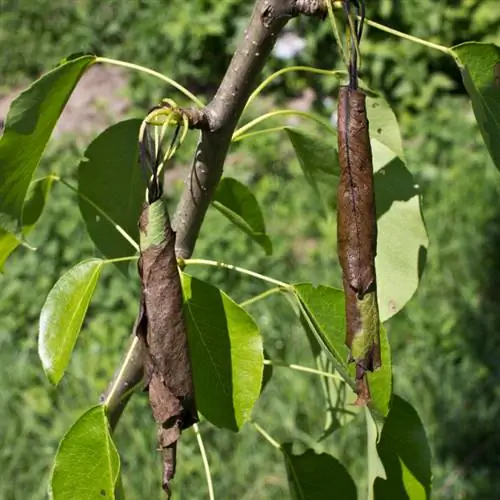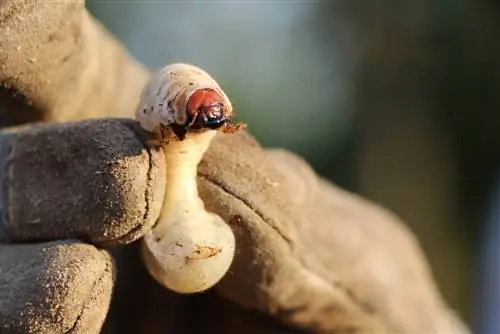- Author admin [email protected].
- Public 2023-12-16 16:46.
- Last modified 2025-06-01 06:02.
Every spring, hobby gardeners compete head-to-head with voracious Colorado potato beetle larvae for valuable potato plants. Anyone who can identify the pests by their appearance is clearly ahead. This guide explains with words and pictures how to accurately identify a Colorado potato beetle larva. This is how you fight the insatiable enemies in the potato patch using natural means.

How do you recognize and combat Colorado potato beetle larvae?
Potato beetle larvae are 2-10 mm long, bright red or reddish-yellow and have a black head and neck shield. They cause damage to potato plants and can be controlled biologically, for example by collecting them, shaking them off, using organic sprays (neem, plant broth, rock dust) or home remedies (coffee grounds, moonamine, wood ash).
- A Colorado potato beetle larva is 2-10 mm long, bright red, later reddish-yellow, has 6 short legs, a black head and a black neck shield.
- Special feature are 2 black rows of dots on each side of the elongated, cylindrical body.
- Biological control methods are: collecting, shaking off, organic sprays (neem, plant broth, rock dust) and home remedies (coffee grounds, moonamine, wood ash).
Identify potato beetle larva
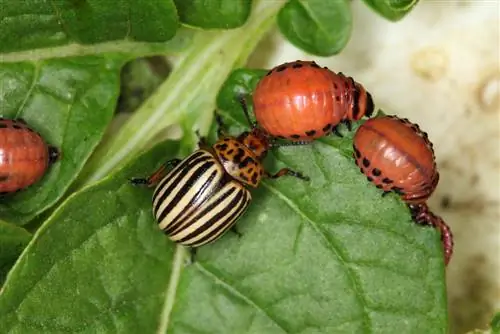
Potato beetle larvae hardly look like their parents
The appearance of a Colorado potato beetle larva is far removed from the yellow and black striped warning costume of adult Colorado beetles. Nevertheless, specific features characterize the appearance, which enable reliable identification even to the untrained eye. The first appearance of the pests can be expected from the end of May/beginning of June. At this time, the Colorado potato beetle larva hatches from its orange-yellow egg, which its mother placed two weeks earlier on the underside of the leaf of a young potato plant. The larva cannot complain about being lonely, as eggs are laid in packets in numerous clutches of around 20 eggs each. Within three to four weeks, a Colorado potato beetle larva goes through four larval stages (L1-L4) and changes size and color:
- Larval stages L1 and L2: 1-3 mm long, bright red to reddish brown
- Larval stages L3 and L4: 4-10 mm, reddish-yellow
- Appearance L1 to L4: 6 black legs, black head, black neck shield
- Special identifying feature: 2 black rows of dots on each side of the elongated, cylindrical body

By far the greatest damage is caused by a Colorado beetle larva in the fourth instar (L4). Leaf damage to potato plants is not uncommon during this phase. After the four-week feast in the potato patch, the full-fledged larvae fall to the ground, burrow in and pupate. Two weeks later, ready-made young beetles with yellow and black stripes crawl out of the ground and begin producing the second generation. The pictures below show the development of a Colorado potato beetle larva from L1 to L4.
Fighting potato beetle larvae - organic methods at a glance
When nature-loving hobby gardeners cross swords with insatiable Colorado potato beetle larvae, organic methods take precedence. What commercial farmers spray tons of pesticide in potato fields is not allowed in private allotments and is not permitted anyway. However, ecologically ambitious allotment gardeners do not immediately throw in the towel. In fact, the arsenal is well stocked with natural anti-potato beetle weapons, as the following table shows:
| Manual control | Biological sprays | Home remedies | |
|---|---|---|---|
| Collect | Neem | Coffee grounds | |
| Shake it off | Plant stock | Mondamin | |
| Rock flour | Wood ash |
The ultimate cure for Colorado potato beetle larvae has yet to be invented. In fact, Colorado potato beetles are masters of adaptation. Since being introduced at the beginning of the 20th century, the pests have quickly developed resistance to arsenic, DDT and other poisons. Modern pesticides, such as pyrethroids, are increasingly losing their effectiveness in commercial potato cultivation. Nature-based hobby gardeners transfer this knowledge to the use of natural control agents against Colorado potato beetle larvae. The effectiveness of biological methods is based on a well-thought-out combination and alternating use, so that the beasts do not have time to adjust to them.
In the following video, Professor Dr. Kühne has his say, a luminary in the field of combating Colorado potato beetles. Join the expert on a short journey through time that will illustrate why Colorado potato beetles and their larvae are so difficult to get rid of.

Fighting potato beetle larvae manually - this is how it works
Manual methods undermine the ingenious adaptability of Colorado potato beetle larvae. When collecting and shaking off, target the pests individually.
- Best time: From mid/end of April every few days until August
- Fill empty PET bottle halfway with water
- In the morning collect larvae and beetles from the leaves and throw them into the water bottle
- Alternatively, spread out a film, shake the plant and collect fallen pests
Finally, please check all undersides of the leaves carefully. Discover orange-yellow eggs here, strip the clutches by hand or with kitchen paper.
Excursus
Preventing potato beetles - tips & tricks
Natural hobby gardeners act according to the motto: Preventing Colorado potato beetle larvae is better than fighting them. Two effective methods aim to prevent Colorado potato beetles from laying eggs. In early spring, dig the kitchen garden two spades deep. Ideally, you sieve the garden soil using a sieve. You catch the adult beetles in hibernation and nip the threatening plague in the bud. Because you can never be sure whether you have destroyed the entire population, wet the soil afterwards. A close-meshed protective net catches all Colorado beetles that crawl out of the ground and prevents them from approaching young potato plants, tomatoes and other nightshade plants.
Organic spray against Colorado potato beetle larvae
As a biological spray against the destructive Colorado potato beetle larvae, an extract from neem seeds is said to be most effective. Nature-oriented hobby gardeners swear by plant decoction as a liquid and rock powder as a dry spray against the feeding larvae. The following quick instructions explain the details:
Neem versus Colorado potato beetle larva
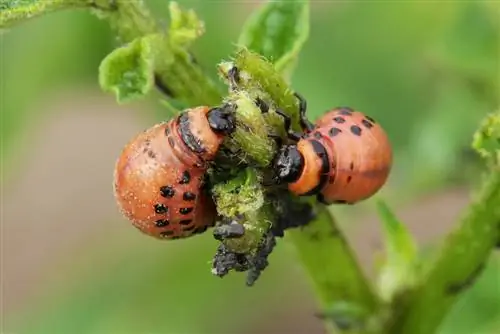
Neem preparations stop feeding and reproduction
The biological insecticide Bio Pest Free Neem (€19.00 at Amazon) from Naturen is a liquid azadirachtin extract from neem seeds. When applied to the young potato plants, the agent stops feeding within a few hours. In addition, the entire reproduction process comes to a standstill. The preparation is bee-friendly, biodegradable and also approved for use in home and allotment gardens.
Plant stock
If you spray potato plants regularly with plant broth, the Colorado beetle larvae will lose their desire to eat the leaves and females who like to reproduce will turn away in disgust as soon as they approach. Various herbs can be considered as ingredients for the organic spray. Production and use in the home garden are incredibly easy. How to do it right:
- Collect 1000 grams of leaves from nettles, mint, ferns or thuja (green needled shoot tips)
- Put green waste in a large cauldron
- Pour 10 liters of water over it and bring to the boil
- Simmer gently for 20 to 30 minutes, stirring occasionally
- Remove the pot from the fire and set aside
- Let it steep for 24-48 hours
- Sift the plant broth and fill it into a spray bottle or pressure sprayer
- Spray potato plants and other nightshade plants every 3 to 4 days (please don't forget the undersides of the leaves)
The natural remedy is optimally effective before and during egg laying (beginning/mid-April) and shortly after the first larvae hatch (L1).
Rock flour
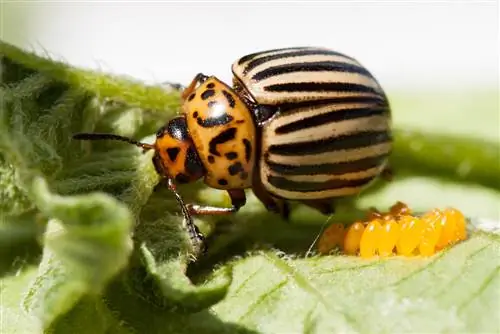
Rock dust prevents Colorado potato beetles from laying eggs
If mildew or other fungal infections are rampant in the home garden, liquid control agents are unsuitable. Permanently moist leaves provide ideal living conditions for fungal spores. This does not mean that you have to admit defeat to Colorado potato beetle larvae. With a wafer-thin layer of rock dust, you prevent egg laying and spoil the appetite of any larvae that are already there. You can optionally sprinkle the product on by hand. It is better to use a powder syringe.
Tip
A bed border made of perennial flax (Linum perenne), nasturtium (Tropaeolum or horseradish (Armoracia rusticana) forms a green bulwark against Colorado potato beetles. These plants exude special scents above and below ground that drive away egg-laden females.
Home remedies to combat Colorado potato beetle larvae
Home remedies are not a panacea against Colorado potato beetle larvae. At least they can increase the effectiveness of other biological methods. How to do it right:
- Coffee grounds: Scatter dried coffee grounds in the bed every 4 weeks, spread thinly on plant leaves
- Mondamin: use as a cost-effective alternative to rock dust
- Wood ash: Apply pure ash (without toxic combustion residues) to the top and bottom of the leaves using a powder syringe
These home remedies with plant decoctions achieve a powerful synergy effect. If the potato leaves are still slightly damp from the organic spray, sprinkle coffee grounds, Mondamin or wood ash.
Frequently asked questions
What do adult Colorado beetles look like?
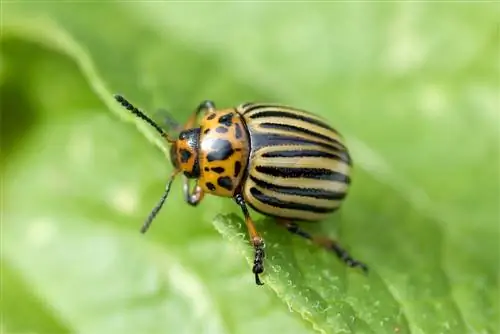
Adult Colorado potato beetles are orange-yellow with black stripes
Adult Colorado potato beetles have a distinctive appearance. The roundish-oval body is 7 to 15 mm long and striped black and yellow. Each of the light yellow, shiny cover wings is decorated with 5 black longitudinal stripes. Black spots on the yellow-orange pronotum are characteristic. There are no distinctive features on the reddish-brown underside of an adult Colorado potato beetle. Black antennae and 6 thin legs complete the visual appearance.
Is the Colorado potato beetle larva only harmful to potato plants?
No, unfortunately the food spectrum of Colorado potato beetle larvae extends across numerous nightshade plants. Tomato plants, peppers, chilli, eggplants and even tobacco plants are also eaten with great appetite. Refraining from growing potatoes in your own garden is therefore no guarantee that you will be spared from a plague of Colorado potato beetles.
Can Colorado potato beetle larvae bite?
Like most beetles, Colorado potato beetles and their larvae have chewing and biting tools for feeding. Of course, this mouthpart is only sufficient to feed on delicate plant leaves. The so-called mandibles are far too weak to bite into human skin.
Are there beneficial insects against Colorado potato beetle larvae?
The Colorado potato beetle is an introduced pest from North America. This circumstance plays into the invader's hands because there are no predators in Europe. Birds, ground beetles, predatory bugs and other beneficial insects disdain both the adult beetles and the reddish larvae. It remains to be seen whether, in the course of evolution, parasites such as lacewings or parasitic wasps recognize the Colorado potato beetle larva as potential prey.
Tip
The high expectations of the biocide Novodor FC as a control agent against Colorado potato beetles have not been fulfilled. The non-toxic bacilli contained in the agent called Bacillus thuringiensis subspecies tenebrionis should cause Colorado beetle larvae to stop feeding immediately. At the request of the authorization holder, the approval as a plant protection product was revoked on April 30, 2019. This does not apply to Bacillus thuringiensis israelensis. This strain of bacilli is still available to combat mosquito larvae.


